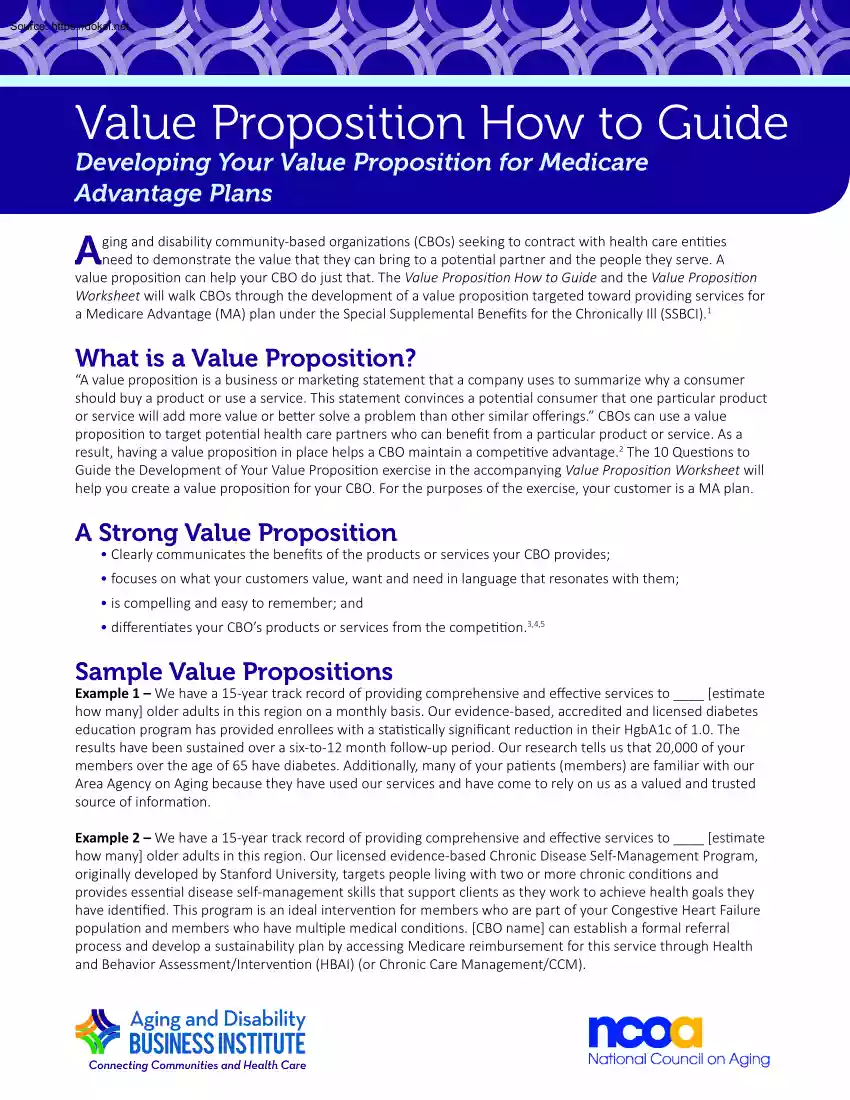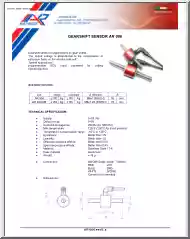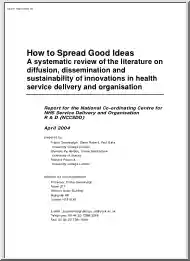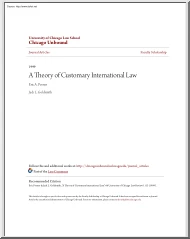Please log in to read this in our online viewer!

Please log in to read this in our online viewer!
No comments yet. You can be the first!
What did others read after this?
Content extract
Value Proposition How to Guide Developing Your Value Proposition for Medicare Advantage Plans A ging and disability community-based organizations (CBOs) seeking to contract with health care entities need to demonstrate the value that they can bring to a potential partner and the people they serve. A value proposition can help your CBO do just that. The Value Proposition How to Guide and the Value Proposition Worksheet will walk CBOs through the development of a value proposition targeted toward providing services for a Medicare Advantage (MA) plan under the Special Supplemental Benefits for the Chronically Ill (SSBCI).1 What is a Value Proposition? “A value proposition is a business or marketing statement that a company uses to summarize why a consumer should buy a product or use a service. This statement convinces a potential consumer that one particular product or service will add more value or better solve a problem than other similar offerings.” CBOs can use a value
proposition to target potential health care partners who can benefit from a particular product or service. As a result, having a value proposition in place helps a CBO maintain a competitive advantage.2 The 10 Questions to Guide the Development of Your Value Proposition exercise in the accompanying Value Proposition Worksheet will help you create a value proposition for your CBO. For the purposes of the exercise, your customer is a MA plan A Strong Value Proposition • Clearly communicates the benefits of the products or services your CBO provides; • focuses on what your customers value, want and need in language that resonates with them; • is compelling and easy to remember; and • differentiates your CBO’s products or services from the competition.3,4,5 Sample Value Propositions Example 1 – We have a 15-year track record of providing comprehensive and effective services to [estimate how many] older adults in this region on a monthly basis. Our evidence-based,
accredited and licensed diabetes education program has provided enrollees with a statistically significant reduction in their HgbA1c of 1.0 The results have been sustained over a six-to-12 month follow-up period. Our research tells us that 20,000 of your members over the age of 65 have diabetes. Additionally, many of your patients (members) are familiar with our Area Agency on Aging because they have used our services and have come to rely on us as a valued and trusted source of information. Example 2 – We have a 15-year track record of providing comprehensive and effective services to [estimate how many] older adults in this region. Our licensed evidence-based Chronic Disease Self-Management Program, originally developed by Stanford University, targets people living with two or more chronic conditions and provides essential disease self-management skills that support clients as they work to achieve health goals they have identified. This program is an ideal intervention for
members who are part of your Congestive Heart Failure population and members who have multiple medical conditions. [CBO name] can establish a formal referral process and develop a sustainability plan by accessing Medicare reimbursement for this service through Health and Behavior Assessment/Intervention (HBAI) (or Chronic Care Management/CCM). The following exercises are included in the accompanying Value Proposition Worksheet, which will guide CBOs through the process of creating a value proposition. Please use the Value Proposition Worksheet, available at www.aginganddisabilitybusinessinstituteorg/value-proposition-how-to-guide-and-worksheet/, to respond to questions and develop your value proposition. 10 Questions to Guide the Development of Your Medicare Advantage Value Proposition 1. What is the problem you intend to address? 2. What is the specific intervention that you will use to address this problem? 3. Is your product innovative or is it a common service that is
delivered in an innovative way? 4. What opportunities for delivering Special Supplemental Benefits for the Chronically Ill (SSBCI) can you capitalize on, and what key concerns or “pain points” for an MA plan can your product/service address? Be sure to consider the potential customer’s financial and quality risks. 5. How will your service address the customer’s risk? 6. What is the customer’s market penetration? 7. What are the types of beneficiaries served, and what challenges are faced by this target population? 8. What level of access do you have to the target population? How can you effectively reach the customer’s target population? 9. Are you targeting a specific population within the MA plan, eg, people living with diabetes, Congestive Heart Failure, or people at risk for falls? 10. Document how your program will: a. Reach and provide services to the target population b. Demonstrate effectiveness for individuals and the overall population served (What kind of outcome
data will be used to validate efficacy?) c. Define the Return on Investment (ROI) for the customer (Note that there are two types of ROI: hard and soft.)6 d. What is the role of your primary contact with the customer? What’s their stake/perspective in solving the problem you identified in questions 1-2? Writing Your Own Value Proposition 1. Reviewing your responses to the 10 Questions to Guide the Development of Your Value Proposition exercise, extract the key elements in bullet points to describe why your potential customer would want to offer or purchase this product or service for their members and what makes it innovative, unique or better than a similar service offered by your competitors. 2. Next, combine your bullet points into a strong, succinct and compelling statement about why your service is valuable and how it can help address concerns your potential partners may have. Use industry jargon or nomenclature that will resonate with a health care audience (e.g, quality
improvement, return on investment, HEDIS, CAHPS, etc.) Tailor the presentation statement to the person’s role in solving the problem in the organization (i.e, marketing, population health management, provider network management) 2 Steps to Take After Developing Your CBO’s Value Proposition After patting yourself on the back for creating your CBO’s value proposition, the steps described below will help you embed it within your organizationand help your CBO prepare to make its case with potential customers. Practice It Now that you have developed your value proposition, practice presenting it to internal team members and partners, enlist their feedback and refine your statement as needed. Embed and Share It As a final step, it is important to embed your value proposition into your overall marketing plan and to share it throughout your CBO. Ensure that your leadership team, staff, and volunteers understand and are able to effectively articulate the value proposition. Also,
use a variety of communication channels (newsletters, website, social media, print materials, etc.) to promote the unique value of your product or service. Additional Resources • Aging and Disability Business Institute, Define Your Value, https://www.aginganddisabilitybusinessinstituteorg/ resources/category/define-your-value. • National Council on Aging, Developing Your Value Proposition, Slides from NCOA’s 2017 National CDSME and Falls Prevention Annual Meeting, https://www.ncoaorg/wp-content/uploads/NCOA-Value-Prop-FINAL-052217pdf • National Council on Aging, Value Proposition Tips and Sample Statement for Partnering with Patient-Centered Medical Homes and Federally Qualified Health Centers, https://www.ncoaorg/wp-content/uploads/3-4-ValueProposition-Tips-72716pdf This worksheet was originally created by the National Council on Aging (NCOA) for the Medicare Reimbursement Learning Collaborative, which was funded through the National Chronic Disease Self-Management Education
Resource Center by the Administration on Community Living, U.S Department of Health and Human Services The worksheet was adapted as part of the Medicare Advantage Learning Collaborative, which is funded by the Administration for Community Living, U.S Department of Health and Human Services through cooperative agreements to the National Association of Area Agencies on Aging (n4a) and NCOA. 3 Endnotes 1 Aging and Disability Business Institute, 2020 Final Call Letter Offers Guidance and Structure for Medicare Advantage Supplemental Benefits, https://www.aginganddisabilitybusinessinstituteorg/2020-final-call-letteroffers-guidance-and-structure-for-medicare-advantage-supplemental-benefits 2 Investopedia, Value Proposition, http://www.investopediacom/terms/v/valuepropositionasp#ixzz49NqT81QP 3 MindTools, Creating a Value Proposition, https://www.mindtoolscom/CommSkll/ValuePropositionhtm 4 Marketing Experiments, Landing Page Optimization: Identify and Express Why I Should Buy from
You, https://marketingexperiments.com/value-proposition/develop-express-value-proposition 5 BPlans, How to Create a Unique Value Proposition, http://articles.bplanscom/create-value-proposition/ 6 Aging and Disability Business Institute, Returns Worth the Investment, https://www.aginganddisabilitybusinessinstituteorg/returns-worth-the-investment June 2020 This project was supported, in part by grant number 90PPBA0001-03-00 and 90CS0058 from the U.S Administration for Community Living (ACL), Department of Health and Human Services, Washington, D.C 20201 Grantees undertaking projects with government sponsorship are encouraged to express freely their findings and conclusions. Points of view or opinions do not, therefore, necessarily represent official ACL policy. This publication was produced by the Aging and Disability Business Institute and the National Council on Aging (NCOA). Led by the National Association of Area Agencies on Aging (n4a) in partnership with the most experienced
and respected organizations in the Aging and Disability Networks, the mission of the Aging and Disability Business Institute is to build and strengthen partnerships between aging and disability community-based organizations and the health care system. Funded by The John A Hartford Foundation, The SCAN Foundation and the Administration for Community Living, the Aging and Disability Business Institute provides community-based organizations with the tools and resources to successfully adapt to a changing health care environment, enhance their organizational capacity and capitalize on emerging opportunities to diversify funding. Learn more at wwwaginganddisabilitybusinessinstituteorg NCOA is a trusted national leader working to ensure that every person can age well. Since 1950, our mission has not changed: Improve the lives of millions of older adults, especially those who are struggling. NCOA empowers people with the best solutions to improve their own health and economic securityand we
strengthen government programs that we all depend on as we age. Every year, millions of people use our signature programs BenefitsCheckUp®, My Medicare Matters®, and the Aging Mastery Program® to age well. By offering online tools and collaborating with a nationwide network of partners, NCOA is working to improve the lives of 40 million older adults by 2030. Learn more at www.ncoaorg and @NCOAging 4
proposition to target potential health care partners who can benefit from a particular product or service. As a result, having a value proposition in place helps a CBO maintain a competitive advantage.2 The 10 Questions to Guide the Development of Your Value Proposition exercise in the accompanying Value Proposition Worksheet will help you create a value proposition for your CBO. For the purposes of the exercise, your customer is a MA plan A Strong Value Proposition • Clearly communicates the benefits of the products or services your CBO provides; • focuses on what your customers value, want and need in language that resonates with them; • is compelling and easy to remember; and • differentiates your CBO’s products or services from the competition.3,4,5 Sample Value Propositions Example 1 – We have a 15-year track record of providing comprehensive and effective services to [estimate how many] older adults in this region on a monthly basis. Our evidence-based,
accredited and licensed diabetes education program has provided enrollees with a statistically significant reduction in their HgbA1c of 1.0 The results have been sustained over a six-to-12 month follow-up period. Our research tells us that 20,000 of your members over the age of 65 have diabetes. Additionally, many of your patients (members) are familiar with our Area Agency on Aging because they have used our services and have come to rely on us as a valued and trusted source of information. Example 2 – We have a 15-year track record of providing comprehensive and effective services to [estimate how many] older adults in this region. Our licensed evidence-based Chronic Disease Self-Management Program, originally developed by Stanford University, targets people living with two or more chronic conditions and provides essential disease self-management skills that support clients as they work to achieve health goals they have identified. This program is an ideal intervention for
members who are part of your Congestive Heart Failure population and members who have multiple medical conditions. [CBO name] can establish a formal referral process and develop a sustainability plan by accessing Medicare reimbursement for this service through Health and Behavior Assessment/Intervention (HBAI) (or Chronic Care Management/CCM). The following exercises are included in the accompanying Value Proposition Worksheet, which will guide CBOs through the process of creating a value proposition. Please use the Value Proposition Worksheet, available at www.aginganddisabilitybusinessinstituteorg/value-proposition-how-to-guide-and-worksheet/, to respond to questions and develop your value proposition. 10 Questions to Guide the Development of Your Medicare Advantage Value Proposition 1. What is the problem you intend to address? 2. What is the specific intervention that you will use to address this problem? 3. Is your product innovative or is it a common service that is
delivered in an innovative way? 4. What opportunities for delivering Special Supplemental Benefits for the Chronically Ill (SSBCI) can you capitalize on, and what key concerns or “pain points” for an MA plan can your product/service address? Be sure to consider the potential customer’s financial and quality risks. 5. How will your service address the customer’s risk? 6. What is the customer’s market penetration? 7. What are the types of beneficiaries served, and what challenges are faced by this target population? 8. What level of access do you have to the target population? How can you effectively reach the customer’s target population? 9. Are you targeting a specific population within the MA plan, eg, people living with diabetes, Congestive Heart Failure, or people at risk for falls? 10. Document how your program will: a. Reach and provide services to the target population b. Demonstrate effectiveness for individuals and the overall population served (What kind of outcome
data will be used to validate efficacy?) c. Define the Return on Investment (ROI) for the customer (Note that there are two types of ROI: hard and soft.)6 d. What is the role of your primary contact with the customer? What’s their stake/perspective in solving the problem you identified in questions 1-2? Writing Your Own Value Proposition 1. Reviewing your responses to the 10 Questions to Guide the Development of Your Value Proposition exercise, extract the key elements in bullet points to describe why your potential customer would want to offer or purchase this product or service for their members and what makes it innovative, unique or better than a similar service offered by your competitors. 2. Next, combine your bullet points into a strong, succinct and compelling statement about why your service is valuable and how it can help address concerns your potential partners may have. Use industry jargon or nomenclature that will resonate with a health care audience (e.g, quality
improvement, return on investment, HEDIS, CAHPS, etc.) Tailor the presentation statement to the person’s role in solving the problem in the organization (i.e, marketing, population health management, provider network management) 2 Steps to Take After Developing Your CBO’s Value Proposition After patting yourself on the back for creating your CBO’s value proposition, the steps described below will help you embed it within your organizationand help your CBO prepare to make its case with potential customers. Practice It Now that you have developed your value proposition, practice presenting it to internal team members and partners, enlist their feedback and refine your statement as needed. Embed and Share It As a final step, it is important to embed your value proposition into your overall marketing plan and to share it throughout your CBO. Ensure that your leadership team, staff, and volunteers understand and are able to effectively articulate the value proposition. Also,
use a variety of communication channels (newsletters, website, social media, print materials, etc.) to promote the unique value of your product or service. Additional Resources • Aging and Disability Business Institute, Define Your Value, https://www.aginganddisabilitybusinessinstituteorg/ resources/category/define-your-value. • National Council on Aging, Developing Your Value Proposition, Slides from NCOA’s 2017 National CDSME and Falls Prevention Annual Meeting, https://www.ncoaorg/wp-content/uploads/NCOA-Value-Prop-FINAL-052217pdf • National Council on Aging, Value Proposition Tips and Sample Statement for Partnering with Patient-Centered Medical Homes and Federally Qualified Health Centers, https://www.ncoaorg/wp-content/uploads/3-4-ValueProposition-Tips-72716pdf This worksheet was originally created by the National Council on Aging (NCOA) for the Medicare Reimbursement Learning Collaborative, which was funded through the National Chronic Disease Self-Management Education
Resource Center by the Administration on Community Living, U.S Department of Health and Human Services The worksheet was adapted as part of the Medicare Advantage Learning Collaborative, which is funded by the Administration for Community Living, U.S Department of Health and Human Services through cooperative agreements to the National Association of Area Agencies on Aging (n4a) and NCOA. 3 Endnotes 1 Aging and Disability Business Institute, 2020 Final Call Letter Offers Guidance and Structure for Medicare Advantage Supplemental Benefits, https://www.aginganddisabilitybusinessinstituteorg/2020-final-call-letteroffers-guidance-and-structure-for-medicare-advantage-supplemental-benefits 2 Investopedia, Value Proposition, http://www.investopediacom/terms/v/valuepropositionasp#ixzz49NqT81QP 3 MindTools, Creating a Value Proposition, https://www.mindtoolscom/CommSkll/ValuePropositionhtm 4 Marketing Experiments, Landing Page Optimization: Identify and Express Why I Should Buy from
You, https://marketingexperiments.com/value-proposition/develop-express-value-proposition 5 BPlans, How to Create a Unique Value Proposition, http://articles.bplanscom/create-value-proposition/ 6 Aging and Disability Business Institute, Returns Worth the Investment, https://www.aginganddisabilitybusinessinstituteorg/returns-worth-the-investment June 2020 This project was supported, in part by grant number 90PPBA0001-03-00 and 90CS0058 from the U.S Administration for Community Living (ACL), Department of Health and Human Services, Washington, D.C 20201 Grantees undertaking projects with government sponsorship are encouraged to express freely their findings and conclusions. Points of view or opinions do not, therefore, necessarily represent official ACL policy. This publication was produced by the Aging and Disability Business Institute and the National Council on Aging (NCOA). Led by the National Association of Area Agencies on Aging (n4a) in partnership with the most experienced
and respected organizations in the Aging and Disability Networks, the mission of the Aging and Disability Business Institute is to build and strengthen partnerships between aging and disability community-based organizations and the health care system. Funded by The John A Hartford Foundation, The SCAN Foundation and the Administration for Community Living, the Aging and Disability Business Institute provides community-based organizations with the tools and resources to successfully adapt to a changing health care environment, enhance their organizational capacity and capitalize on emerging opportunities to diversify funding. Learn more at wwwaginganddisabilitybusinessinstituteorg NCOA is a trusted national leader working to ensure that every person can age well. Since 1950, our mission has not changed: Improve the lives of millions of older adults, especially those who are struggling. NCOA empowers people with the best solutions to improve their own health and economic securityand we
strengthen government programs that we all depend on as we age. Every year, millions of people use our signature programs BenefitsCheckUp®, My Medicare Matters®, and the Aging Mastery Program® to age well. By offering online tools and collaborating with a nationwide network of partners, NCOA is working to improve the lives of 40 million older adults by 2030. Learn more at www.ncoaorg and @NCOAging 4




